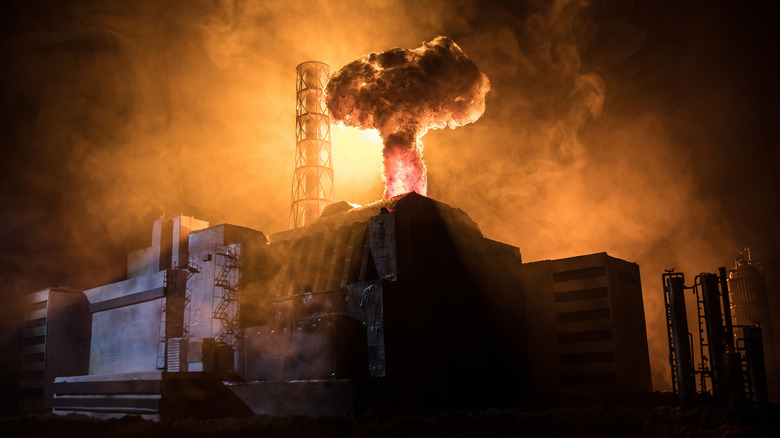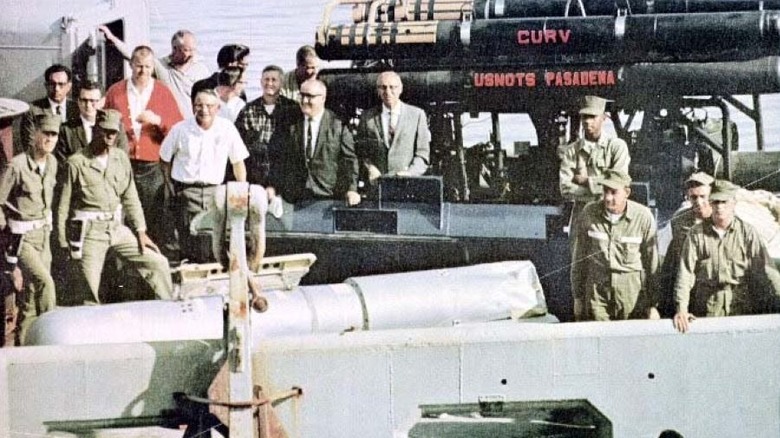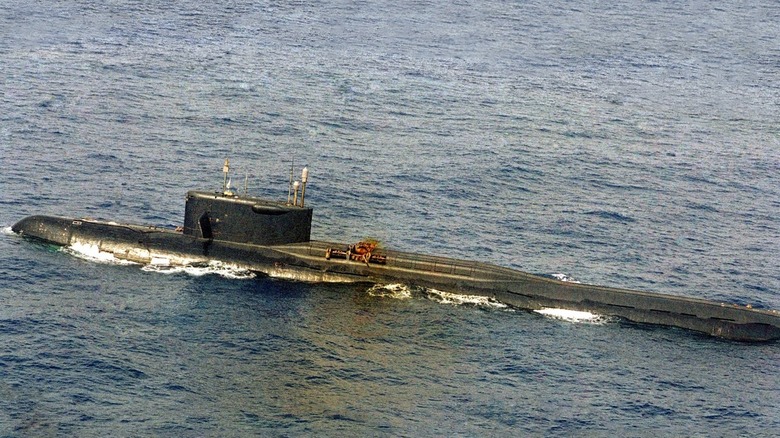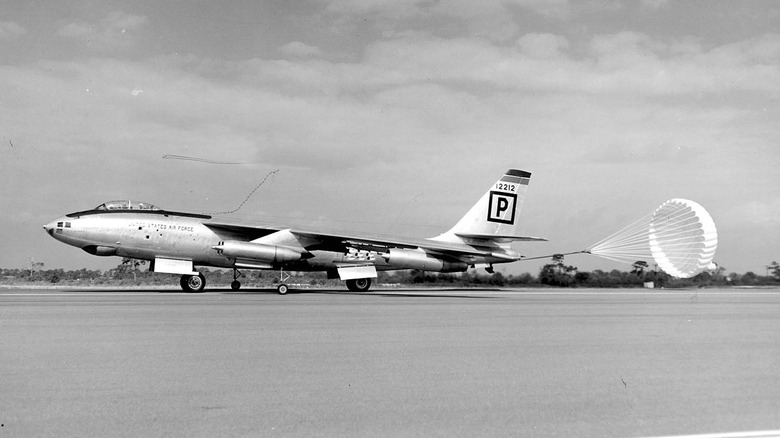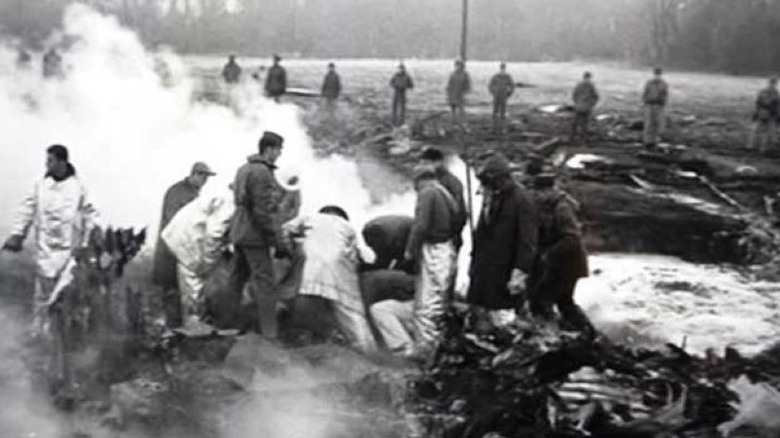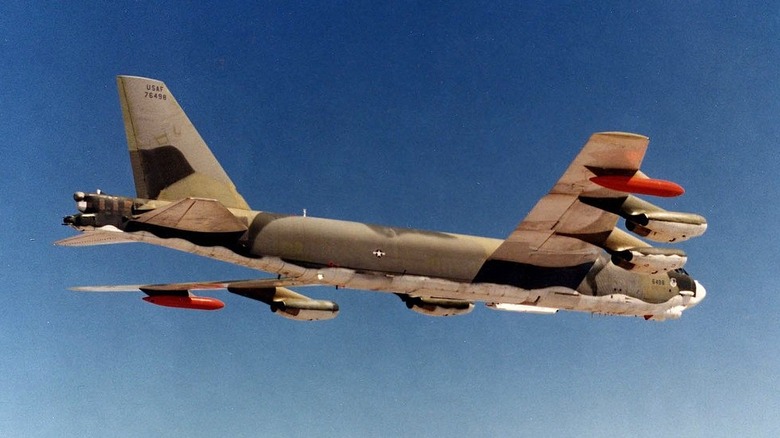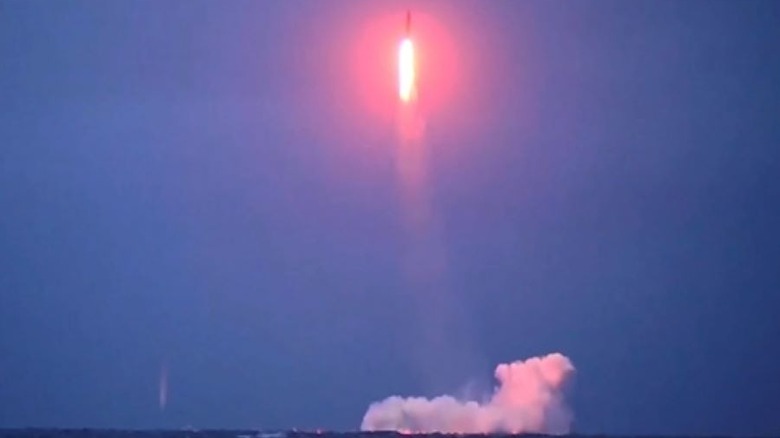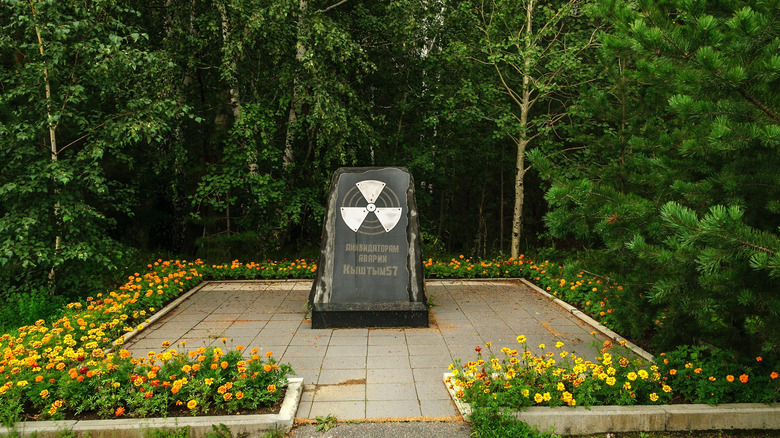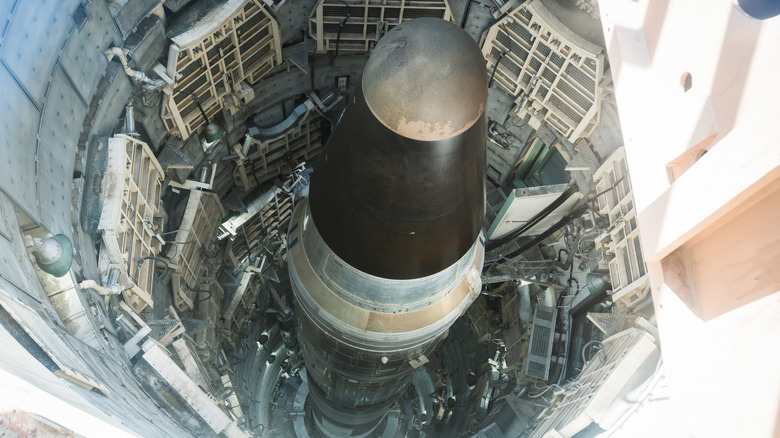10 Of The Worst Military Accidents Involving Nuclear Weapons Throughout History
The Cold War's nuclear brinksmanship involved a strategy that demanded the United States and the U.S.S.R. be constantly prepared to launch nuclear weapons. The necessity for regular patrols of nuclear-armed weapons platforms was a chilling effect of this geopolitical knot. The concept of mutual assured destruction — fittingly known as MAD — meant that forces had to be ready to counter an enemy launch at a moment's notice. This scenario would only lead to more death and destruction, but that was the stark reality of the game.
Scientists and engineers on both sides worked to develop nuclear delivery methods that could strike the enemy as fast and ferociously as possible. The belligerents stockpiled nuclear weapons and created aircraft and ships that could rain hell in the event of a launch. Bombers orbited near enemy territory. Submarines lurked off the coasts of cities. At any given time, a slew of military vehicles transited the earth, transporting nuclear material, bombs, and missiles.
Even in the most meticulously planned operations, the unexpected can occur. The Cold War was no exception with its global duel of nuclear supremacy. Over the decades, a series of military accidents involving nuclear weapons put millions of lives at risk. Governments on both sides attempted to keep these mishaps under wraps, but the fallout from these events — pun intended — eventually reached the press and public. We include incidents that include loss of life, environmental damage, and potential political and physical damage that may have been caused as a result.
We've compiled a list of 10 of the worst military accidents involving nuclear weapons throughout history — and these are just the ones we know about.
The Palomares Incident
The United States Air Force's B-52 Stratofortress strategic bombers were the mainstay of nuclear air patrol, and one was responsible for one of the most potentially devastating nuclear accidents in history.
On January 16, 1966, a B-52G departed North Carolina for an extended patrol orbiting near Turkey. Onboard were four B28 thermonuclear bombs. Each employed a 1.1 megaton (Mt) or 1,100 kiloton (kt) warhead. A detonation of a single B28 on the surface could result in a mile-wide fireball several times brighter than the sun, a 2.7 km radius of fatal radiation exposure, and fallout spreading to an even wider area.
The B-52 successfully refueled twice before disaster struck. On the third mid-air fueling, the KC-135 fueling plane's boom struck the bomber, snapping off the left wing. The plane promptly crashed near the Spanish village of Palomares, killing seven airmen.
In its crash, the plane scattered the four nuclear bombs to the winds. Three of them landed miles apart, two of them cracked enough to leak plutonium, though mercifully none detonated. The problem was the fourth weapon, which had disappeared into the Mediterranean Sea. The U.S. Navy dispatched more than 30 ships and a submersible to scour the area. Nearly three months later, the Navy secured the fourth nuke, dented and damaged, from the sea floor.
The Palomares Incident left behind two radioactive trenches, which contaminated about 100 acres of Spanish land. The United States only agreed to clean up the remainder of the pollution in 2015.
K-219
In October 1986, disaster unfolded as Ronald Reagan and Mikhail Gorbachev prepared to meet in Reykjavik, Iceland. About 700 miles off the coast of Bermuda, the Soviet Yankee-class ballistic missile submarine K-219 was in serious trouble. The seal of one of its missile tubes had failed, mixing seawater with missile fuel and creating a toxic fire.
Captain Igor Britanov called for help as K-219's reactor cooling system threatened to fail. A 20-year-old crewman named Sergey Preminin sacrificed his life shutting down the reactors and arresting the meltdown. Britanov ordered an evacuation as a Soviet merchant ship arrived on the scene. It took the beleaguered sub under tow but couldn't prevent the tow line from snapping. Britanov was the last man off as the submarine sank to the bottom 19,000 feet below.
In the process of sinking, K-219's missile silos opened, spilling at least 16 R-27U nuclear missiles into the deep, not to mention the boat's two nuclear reactors. Each missile carried a 200-kiloton warhead. For reference, the bomb dropped on Hiroshima in 1945 was between 16 and 17 kilotons.
The United States offered to help salvage the ship, but the Soviet Union refused. Both sides knew that access to the wreckage would be an intelligence bonanza for the Americans. A decade earlier, Howard Hughes and the CIA stole another sunken Soviet nuclear missile sub from the ocean's bottom. If you're hoping for a happy ending, keep hoping. Due to the depth of the wreck, the missiles could not be salvaged. They remain on the bottom, rusting and waiting.
1956 RAF Lakenheath nuclear weapons accident
On July 27, 1956, an American B-47 of the 397th Bombardment Wing attempted a touch-and-go maneuver at the Royal Air Force (RAF) Lakenheath airfield 20 miles from Cambridge, England. The operation required the bomber to make a soft landing before initiating an immediate takeoff and returning to the sky. Unfortunately for the four airmen aboard, the jet bounced on the runway, lost control, and careened off the runway, exploding in a ball of flames.
Unlike in many entries on this list, the vehicle did not carry weaponry. However, it ended its ill-fated flight by smashing against an igloo specially designed to house nuclear weapons. Aviation fuel sprayed everywhere, including all over three Mk 6 nuclear bombs being stored in the facility.
Essentially an improved version of the Fat Man bomb that fell on Nagasaki, Japan, each Mk 6 implosion-triggered bomb had a maximum yield of between 120 and 150 kilotons. About 8,000 pounds of conventional high explosives acted as a detonator for the nuclear material. Base firefighters rushed to the scene, desperately trying to put out the fire before it could set off the bombs.
The fire crew may have saved England that day. "It is possible that a part of Eastern England would have become a desert," remarked a now-retired Air Force general who was in the country at the time, per UPI. However, CambridgeshireLive remembers another officer who put it differently: "Near disaster was averted by tremendous heroism, good fortune, and the will of God."
Castle Bravo test
World War II ended with the opening of the nuclear age. The bombs that ended the conflict were rudimentary and underpowered compared to those developed later. Through the rest of the 1940s and into the 1950s, the American government tested ever more powerful nuclear weapons –- and not all the tests went well.
On March 1, 1954, the U.S. government conducted a nuclear test on Bikini Atoll in the Marshall Islands. The detonation, which had a yield of 15 megatons, was a thousand times more powerful than the Hiroshima bomb. What was particularly striking was that the yield was three to six times more powerful than the testers had anticipated and prepared for.
The explosion dispersed radioactive material over a 100-mile-wide area, affecting the inhabitants of the Marshall Islands. The children of Rongelap Atoll, unaware of the danger, played in the fallout, mistaking it for snow due to its white, flaky appearance. The 23-man crew of a Japanese fishing vessel, the Lucky Dragon, also fell victim to the radiation.
The United States evacuated approximately 200 civilians and 28 military personnel from the area, but the damage was irreversible. The initial blast and fallout did not result in immediate casualties, but the crew of the Lucky Dragon showed later symptoms of moderate acute radiation syndrome.
Goldsboro B-52 crash
On January 24, 1961, the United States earned the unfortunate distinction of bombing itself with a nuclear weapon. An Air Force B-52 Stratofortress strategic bomber was taking part in the same strategy to keep atomic weapons aloft at all times, known as Operation Chrome Dome, that precipitated the Palomares Incident. The aircraft developed a fuel leak, which unsettled the plane. The pilots tried dumping fuel to correct the plane's balance, but it wasn't enough.
Pilot Stephen Tullock ordered the crew to bail out. Eight servicemen did so — with one dying in the jump — while two remained onboard along with a pair of Mark 39 nuclear bombs. Each weighed 10,000 pounds and used parachutes to deploy the weapon properly.
Accounts differ as to the ejection of the bombs. Some say one deployed under its parachutes and floated to the ground before it was entangled in a tree. The other is believed to have fallen out or gone down with the plane. One of the recovered weapons showed that all but one of the safety switches preventing a nuclear detonation failed, leaving the state of North Carolina a hair's breadth from a nuclear holocaust.
The other bomb disappeared and has never been recovered. It hit the ground somewhere in Wayne County at an estimated speed of 700 mph. The government searched for the missing nuclear weapon in a farmer's field, excavating the ground up to 50 feet deep in an unsuccessful effort. The weapon and its uranium remain missing to this day, with the Air Force obtaining an easement prohibiting anyone from digging in the area.
Thule Air Base crash
During an alert mission over Baffin Bay in the North Atlantic Ocean, another Air Force B-52 was flying from Thule Air Base in Greenland. Onboard were four thermonuclear weapons. A cabin fire forced the crew to abandon the aircraft, which promptly slammed into the sea ice below, detonating the high-explosives ignition components of the weapons. The resulting explosion dispersed radioactive material over a great deal of the mercifully uninhabited area.
The Air Force deployed a Disaster Control Team in an enormous attempt to recover any contaminated debris in Operation Crested Ice. Led by Nate Benedict and Joe Tinney, the team used a new device known as a Field Instrument for Detection of Low Energy Radiation (FIDLER) in temperatures as low as -40 degrees Fahrenheit to plot the spread of the material.
The cleanup effort resulted in motivation for the Livermore and Los Alamos nuclear laboratories to continue research into safe use of insensitive high explosives in nuclear weapons.
Nyonoak radiation accident
We'd like to think accidents involving nuclear missiles are a Cold War relic, but the unfortunate truth says otherwise. American officials noticed a radiation-releasing explosion that took place in Russia in August of 2019. It was detected in the vicinity of Russia's Nenoksa Missile Test Site along the coast of the White Sea. Two plus two usually equals four, and in this case, everything added up.
The accident came after a failed missile test ejected a nuclear weapon into the sea. Russia ordered an evacuation of the area and then canceled the order four hours later. A series of radiation sensor sites also went dark during the event, suggesting Russia's intent to cloak the catastrophe. Russian state media reported an explosion of a liquid-fueled jet engine — which is decidedly non-radioactive
Russia eventually owned up to the radiation but not the source, claiming that a small nuclear reactor had been involved in an accident in an energy experiment. United States officials announced they suspected the truth to be somewhat more sinister. The Russians, the U.S. suspected, were testing a prototype cruise missile known to NATO as the SSC-X-9 Skyfall.
The Skyfall was planned to counter American missile defense countermeasures designed to intercept intercontinental ballistic missiles (ICBM) in outer space. The nuclear cruise missile is a concept the United States had long dismissed full-scale nuclear ICBMs as environmentally irresponsible — although what atomic weapon isn't — in addition to being technically and strategically unfeasible.
The accident killed seven nuclear scientists and probably wasn't so good for the surrounding area, either.
Kyshtym explosion
Not all nuclear weapons accidents come from errant bombs and missiles. Some occur during the complex process required to produce nuclear material. One such incident happened in 1957 near Kyshtym, Russia. It proved to be the worst nuclear incident in history until the Russians topped themselves with the far-reaching Chernobyl meltdown.
In the opening days of the Cold War, the Soviet Union rushed to catch up to the United States in nuclear weapons production. Haste makes atomic waste, as the old saying goes, and this one was a doozy. During the late 1940s, the Soviets constructed a secret facility known as Mayak to produce nuclear bombs. Even before the event, the operations at the site ignored safety standards, resulting in 17,245 workers getting irradiated between 1948 and 1958.
Nearby lakes fed the plant's cooling systems, but no one noticed when a cooling cistern on one of the liquid waste storage facilities failed. The radioactive material began to heat until it reached 350 degrees Celsius, then exploded. The blast itself was non-nuclear but rated at the force of 70 tons of TNT.
The meter-thick lid of the cistern blew into the air, followed by a massive quantity of cesium-137 and strontium-90. The flying poison drifted several hundred miles northeast through a heavily populated area. The Soviets tried to keep the event a secret, but hospitals began filling up with victims of radiation sickness. Over 270,000 people were affected, with at least 200 deaths following.
The Kyshtym disaster registered as a Level 6 accident — one shy of the highest — on the International Nuclear Radiological Event Scale, and it was outdone only by the 1986 Chernobyl and the 2011 Fukushima incidents. Russia did not acknowledge its occurrence until 1989.
The Damascus incident
The United States may have ultimately moved away from nuclear ICBMs, but that wasn't always the case. Throughout the Cold War, the nation was dotted with ICBM launch sites concealed underground, ready to launch at a moment's notice.
One such facility was located in Damascus, Arkansas. Protocol in these facilities was, as you might expect, pretty tight. No one wanted one of the missiles stored there to go off accidentally — but how do you safeguard against something as unpredictable as a man dropping a wrench? That's right: a worker at the facility dropped a heavy wrench socket off a work platform. The tool fell 70 feet before hitting one of the missiles, rupturing a pressurized fuel tank. Nothing happened for nearly nine hours. Then the silo ignited, throwing its 700-ton steel cap 14 feet into the air.
The resulting explosion damaged the Titan II –- the heaviest and largest nuclear missile the United States ever built -– inside the silo. With a 15,000-mile range, it was designed to deliver a W-53 9-megaton nuclear warhead to America's enemies. Blessedly, the warhead didn't go off, though several injuries and one death were reported in the incident. It was the end of the line for the troubled Titan II program, as the U.S. dismantled the program shortly after.
Searcy missile silo fire
You're not having deja vu — Arkansas actually suffered a pair of Titan II missile accidents. In 1965, the 308th Strategic Missile Squadron was putting the finishing touches on one of its missile silos. Crews of workmen were called in to improve launch doors and otherwise modify the facility.
On August 9, 1965 (20 years to the day after the Nagasaki bombing), a crew of civilians was working on all nine levels of a launch tube containing a fully-fueled missile. One, a welder, accidentally hit a hydraulic line with his welding rod, which sprayed fuel. The heat ignited the flammable liquid, and a fire ensued.
The silo went dark, lamps replaced by the eerie glow of emergency lights. Men scrambled to escape, but there was too little time to evacuate the massive and confusing labyrinth of underground tunnels and ladderways. By the time the Air Force fire crews responded, it was too late.
The missile did not contain its warhead, but the fire sucked all of the oxygen out of the silo, killing the men inside. Another died from drowning in hydraulic fluid. The only survivors were Hubert A. Saunders, a veteran contractor who was familiar with the layout of the silo, and 17-year-old Gary Lay, who was on his first day on the job.
1983 Soviet nuclear false alarm incident
This one is not as bad as some of the others on this list as it did not result in loss of life or environmental damage, but the sheer potential of what might have happened is astonishing. On September 26, 1983, a Soviet Lieutenant Colonel named Stanislav Petrov monitored a freshly deployed early warning system code named Oko, which tracked American nuclear launches. At midnight, Oko's alarms sounded, indicating that the United States had launched a nuclear attack on the Soviet Union.
American president Ronald Reagan recently boosted his anti-Soviet rhetoric. While tensions were not as high as they had been during the Cuban Missile Crisis, the balance of the world rested on a knife's edge. Protocol demanded that Petrov notify his commanders to prepare to launch a counter-strike. After all, that's what mutual assured destruction was all about. You do us, and we'll take you out before we die.
Relying on gut instinct, which is a major no-no in strictly regulated military protocol, Petrov did — nothing. He did not even notify his superior, choosing instead to wait. The sensors indicated the United States had launched only five missiles. Petrov reasoned that if America were to strike, it would do so with more than five missiles.
He was right. After a time, the alarm quit, and no one exploded in an atomic holocaust of death and destruction. Petrov may have saved the world that day by remaining calm, considering the situation, and choosing not to retaliate against what literally turned out to be a false alarm.
